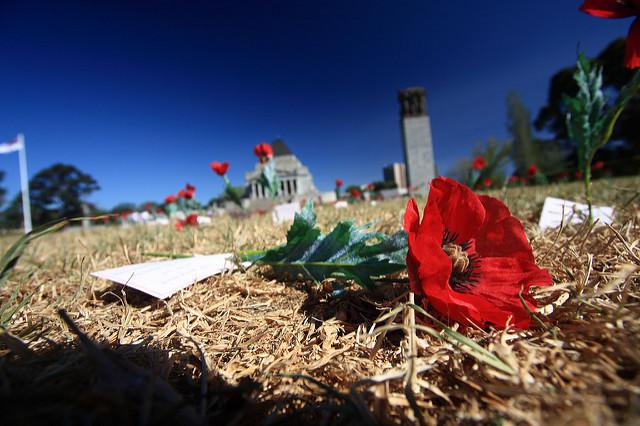Today’s simpler meaning of Anzac Day (part 1)
Posted By Graeme Dobell on April 18, 2016 @ 06:00

Next Monday, April 25, is Anzac Day, the 101st anniversary of the ANZAC landing at Gallipoli. This is the first of two columns by Graeme Dobell reflecting on the commemoration.
For six decades, I’ve known Anzac Day as a fixed moment of season.
The leaves change, the chill begins, the football launches, and then it’s the day for The March.
(In many households it was capitalised like that: The March.)
The March stood for a lot of things. The medals came out and the old comrades assembled for the annual parade.
As a child in the 1950s and a teen in the 1960s, The March meant Melbourne’s St. Kilda Road, leading to the Shrine.
We clapped loudly for my father and his revered and raucous 9th Division mates, striding in step like the young soldiers they’d been. We knew that this was the magnificent 9th. They swaggered again.
The applause was different, gentler, for the slow-moving, ghosting ranks of my Grandfather’s WWI division of original Anzacs.
As the 1950s turned into the 1960s, I vaguely grasped the tensions and the divides, even the politics, which swirled beneath Anzac Day.
Over my six decade span, many of those conflicts of meaning and memory have faded.
The original Anzacs are all gone. And most of the sons and daughters of Anzacs who marched off to WWII march no more.
My father’s generation grew up knowing the Anzac legend in intimate ways. The original Anzacs stood before them as fathers and uncles—or stared down at them as pictures and medals on the mantle, amid the souvenirs of France.
In the 1920s and 1930s, many were taught the legend as a defining expression of Australia as a new nation. Others got the opposing story about a massive waste—sometimes from the lips of those original Anzacs.
That’s why the headline to this piece refers to today’s simpler Anzac Day. Compared to earlier eras, our approach is—relatively—more straightforward.
The understanding of Anzac Day is ever contested. Yet the divides across Australian society are no longer as vivid or as powerful.
Today’s Anzac Day more easily aligns personal remembrance, Australian identity and political purpose. And perhaps the politics doesn’t throb as forcefully.
Not least in this simplification is that old struggles about Australian identity are forgotten.
See this by considering what was once a hallowed term, as important in its way as Anzac: the Australian Imperial Force. My Mum’s father was in the 1st AIF, my father in the 2nd AIF.
For my father, the sense of continuity was as much about the Australian Imperial Force as the Anzac legend.
The term AIF was an identity as significant as the slouch hat. When our military was named the Australian Defence Force in the 1970s, Arthur Tange and his political masters well understood which bit of the tradition they were honouring and which bit had already died.
At its inception, the contest over the meaning and ownership of Anzac Day was the tension between Australian and Imperial.
For some, Empire and Australia were inextricably united. Others believed Australia had sacrificed her youth to unworthy Imperial ends.
Mix into this the great political and sectarian divide that cut through Australia during the conscription referendums of WWI, and throbbed for decades.
For 25 years, Catholics were discouraged from taking part in Anzac Day as a ‘non-denominational’ ceremony honouring the dead. As Jack Waterford [1] notes, the chief Catholic military chaplain, Archbishop Daniel Mannix, saw Anzac days as ‘forbidden to Catholics,’ regarding the RSL hierarchy as ‘morally equivalent to high-grade Freemasons, which, of course, they often were.’
On its foundation in 1916, the RSL’s full title was the Returned Sailors and Soldiers Imperial League of Australia (RSSILA). Imperial meant British and Archbishop Mannix wouldn’t nod to that, nor to the officer class at the top of the RSL.
The RSL’s grip on Anzac Day meant a deeply conservative organisation wielded a great Australian talisman through much of the 20th century.
As a Protestant, my Dad was on the other side of the sectarian divide. Yet he, too, laughed loudly at the ‘The League’ when it was in jingo mode. Still, he worked devotedly for the RSL for many years and was a proud life member.
When old mates were in trouble, the RSL was a network that could be quickly mobilised. He thought The League did more good than harm.
The Imperial versus Australian struggle is absent from today’s understanding of Anzac.
The shift from a British to an Australian identity can be traced through the life of Charles Bean, the scribe who inscribed the Anzac legend into the official history of WWI, and helped create the War Memorial in Canberra.
In Ross Coulthart’s [2] fine biography, Bean starts out as the most jingoistic of Britons, thrilled by imperial might and notions of British racial superiority and purity: ‘Despite this, what is intriguing about Charles Bean is how his personal life story tracks the origins of Australian nationalism. Over the coming decades, his own growing sense of Australian self-identity would transform so much of what he and all Australians had once so passionately believed.’
The journey from Imperial to Australian is part of the story of how the meaning of Anzac Day has been remade.
Article printed from The Strategist: https://aspistrategist.ru
URL to article: /todays-simpler-meaning-of-anzac-day/
URLs in this post:
[1] Jack Waterford: http://www.smh.com.au/comment/anzac-day-best-we-forget-the-rsl-in-peacetime-20150422-1mqhms.html
[2] Ross Coulthart’s: http://www.harpercollins.com.au/9780732297879/charles-bean
Click here to print.